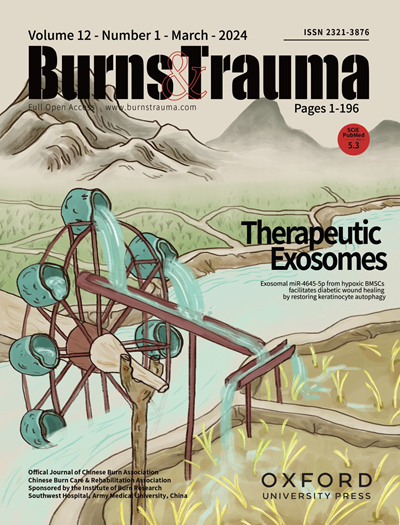Macrophage-derived Exosome piR-50 971 Exacerbates Sepsis-induced Myocardial Injury by Inhibiting Autophagy through the Upregulation of N6-Methyladenosine Modification of mTOR
IF 9.6
1区 医学
Q1 DERMATOLOGY
引用次数: 0
Abstract
Background Sepsis-induced myocardial injury (SIMI) is recognized as a severe complication of sepsis which characterized by a high mortality rate. Notably, the pathophysiology of SIMI involves complex mechanisms, including dysregulation of autophagy. Exosomes contribute to crucial biological processes during sepsis, modulating autophagy processes and facilitating communication between cells.. PIWI-interacting RNAs (piRNAs) are highly expressed in myocardial tissue and exert cardiovascular regulation properties. Therefore, we investigated the role of macrophage-derived exosome piRNAs, specifically piR-50 971, in SIMI and their impact on autophagy through m6A modification of mTOR. Methods A cecal ligation and puncture (CLP) model was established to mimic the pathophysiological features of SIMI. Plasma exosomes were isolated and sequenced to characterize the expression of sepsis-related piRNAs. Bioinformatics analysis was employed to predict the potential regulatory mechanisms involving piR-50 971. To investigate the direct interaction between piR-50 971 and mTOR, a dual-luciferase reporter assay was conducted. Moreover, a methylated RNA immunoprecipitation (MeRIP) assay was conducted to verify the involvement of piR-50 971 in the m6A methylation modification of mTOR transcripts. Additionally, the m6A methylation level was assessed using dot blotting. Results piR-50 971 was identified as a key piRNA upregulated in plasma exosomes during SIMI, which was correlated with the inhibition of autophagy. Increased macrophage infiltration was observed in the myocardium of rats with SIMI. Additionally, cardiomyocytes treated with macrophage-derived exosomes exhibited impaired autophagy. RNA binding protein immunoprecipitation assay demonstrated an interaction between WTAP protein and mTOR mRNA. piR-50 971 interacted with mTOR, leading to increased m6A modification through the regulation of WTAP and subsequent suppression of autophagy. Notably, this regulation upregulated mTOR translation, thereby inhibiting autophagy and exacerbating myocardial injury under septic conditions. In vivo experiments demonstrated that piR-50 971 inhibition ameliorated myocardial injury and improved autophagy in rats with SIMI. Conclusions Our findings reveal a novel mechanism by which macrophage-derived exosome piR-50 971 contributes to SIMI by suppressing autophagy via m6A modification of mTOR. Overall, our results implicate piR-50 971 as a potential target for therapeutic intervention in sepsis-related myocardial dysfunction.巨噬细胞来源的外泌体pir - 50971通过上调mTOR的n6 -甲基腺苷修饰抑制自噬,加重脓毒症诱导的心肌损伤
脓毒症致心肌损伤(SIMI)是公认的脓毒症的严重并发症,其特点是死亡率高。值得注意的是,SIMI的病理生理涉及复杂的机制,包括自噬失调。外泌体在脓毒症中参与关键的生物学过程,调节自噬过程并促进细胞间的通讯。piwi相互作用rna (pirna)在心肌组织中高度表达并发挥心血管调节作用。因此,我们研究了巨噬细胞来源的外泌体pirna,特别是pir - 50971在SIMI中的作用,以及它们通过m6A修饰mTOR对自噬的影响。方法建立模拟SIMI病理生理特征的盲肠结扎穿刺(CLP)模型。分离血浆外泌体并测序以表征败血症相关pirna的表达。利用生物信息学分析预测了mir - 50971的潜在调控机制。为了研究pir - 50971与mTOR之间的直接相互作用,进行了双荧光素酶报告试验。此外,进行了甲基化RNA免疫沉淀(MeRIP)试验以验证pir - 50971参与mTOR转录本的m6A甲基化修饰。此外,采用点印迹法评估m6A甲基化水平。结果pir - 50971是SIMI过程中血浆外泌体上调的关键piRNA,与抑制自噬有关。SIMI大鼠心肌中巨噬细胞浸润增加。此外,用巨噬细胞来源的外泌体处理的心肌细胞表现出受损的自噬。RNA结合蛋白免疫沉淀实验证实WTAP蛋白与mTOR mRNA存在相互作用。pir - 50971与mTOR相互作用,通过调控WTAP和随后抑制自噬导致m6A修饰增加。值得注意的是,这种调节上调mTOR翻译,从而抑制自噬,加重脓毒症条件下的心肌损伤。体内实验表明,抑制pir - 50971可改善SIMI大鼠的心肌损伤和自噬。我们的研究结果揭示了巨噬细胞来源的外泌体pir - 50971通过m6A修饰mTOR抑制自噬来促进SIMI的新机制。总之,我们的研究结果表明pir - 50971是脓毒症相关心肌功能障碍治疗干预的潜在靶点。
本文章由计算机程序翻译,如有差异,请以英文原文为准。
求助全文
约1分钟内获得全文
求助全文
来源期刊

Burns & Trauma
医学-皮肤病学
CiteScore
8.40
自引率
9.40%
发文量
186
审稿时长
6 weeks
期刊介绍:
The first open access journal in the field of burns and trauma injury in the Asia-Pacific region, Burns & Trauma publishes the latest developments in basic, clinical and translational research in the field. With a special focus on prevention, clinical treatment and basic research, the journal welcomes submissions in various aspects of biomaterials, tissue engineering, stem cells, critical care, immunobiology, skin transplantation, and the prevention and regeneration of burns and trauma injuries. With an expert Editorial Board and a team of dedicated scientific editors, the journal enjoys a large readership and is supported by Southwest Hospital, which covers authors'' article processing charges.
 求助内容:
求助内容: 应助结果提醒方式:
应助结果提醒方式:


